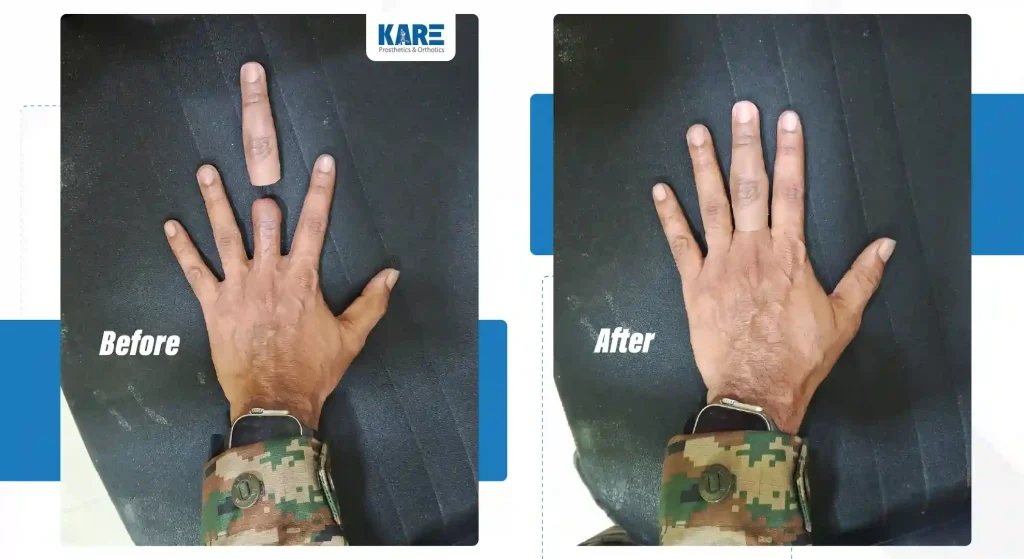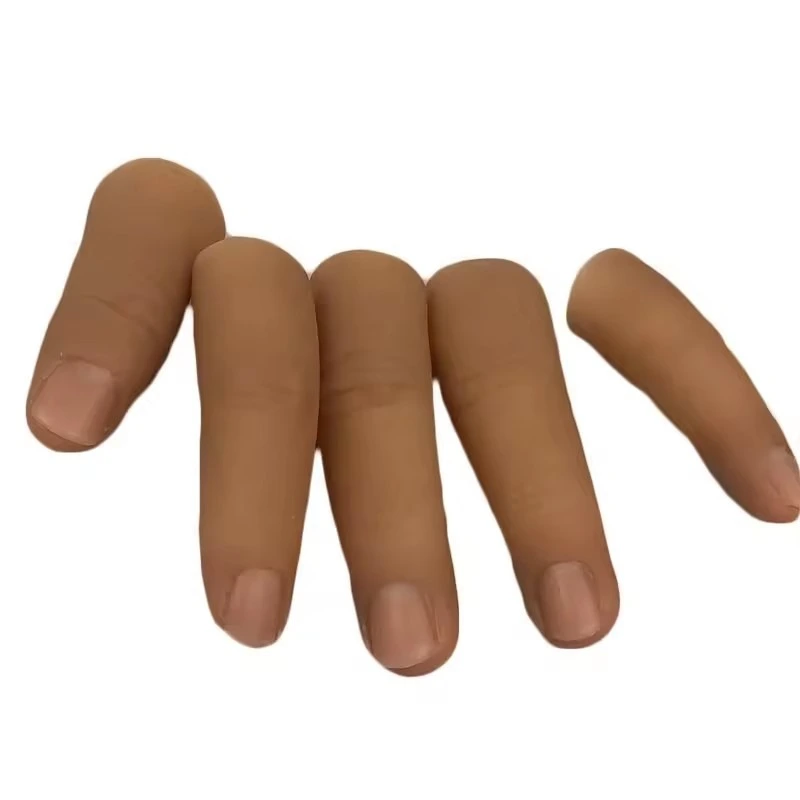
Losing a finger, whether from an accident, injury, or medical condition, can feel overwhelming. Beyond the physical loss, it raises important questions: Can a finger be transplanted? Are artificial fingers a reliable solution? How much do they cost?
While finger transplantation exists, it’s rarely a practical choice. Prosthetic technology, however, has advanced to a level where artificial fingers can restore both appearance and partial function. In this blog, we’ll explore finger transplantation, artificial fingers, their types, costs, and why prosthetics are becoming the go-to solution for many.
What is Finger Transplantation?
Finger transplantation surgery involves attaching a severed finger with stitches. It repairs ruptured blood vessels, tendons, and nerves. However, the success of the surgery depends on:
- How the injury happened
- Condition of the finger
- How much time has lapsed
- Specialised surgical teams
The limited success rate and complex surgery are the reasons why people do not prefer finger transplantation.
Can Lost Fingers be Replaced?
Yes, lost, missing or severed fingers can often be replaced through replantation, or the appearance and functionality can be restored through prosthetic fingers. Replantation is a surgical procedure that can attach the severed finger, including bone, tendons, nerves, and blood vessels. However, prosthetic fingers are fitted to replace the missing finger when replantation is not feasible.
What Is Artificial Finger Surgery?
Artificial finger surgery is an option when a transplant is not possible. In this surgical process, the residual limb is prepared for fitting a prosthetic finger. In some cases, implants or bone reshaping may be performed to enhance comfort and stability before attaching a permanent prosthetic finger. Artificial finger surgery is a medical procedure often performed before fitting a prosthetic finger.
This involves:
- Reshaping bone or soft tissue
- Skin grafting for better coverage.
- Implant placement
- Improving alignment
This surgical preparation ensures that prosthetic fingers sit comfortably and function effectively.
Why Choose Prosthetic Fingers?
Finger transplantation is expensive for most people. It carries risks, and the surgery is not easily accessible. On the other hand, prosthetic fingers offer:
- Faster recovery
- Affordable pricing
- Cosmetic and functional benefit
- Custom fit and natural look
- Very few invasive procedures
How Do Artificial Fingers Work?
Artificial fingers, or prosthetic fingers, are body-powered or myoelectric. The body-powered artificial fingers operate through a system of cables and straps which are connected to the shoulder to translate movement. Myoelectric fingers, on the other hand, use electrodes to detect muscle signals in the residual limb and later convert them into movement commands for the artificial finger.
Types of Artificial Fingers Or Prosthetic Fingers
Transplantation of fingers has a limited success rate; prosthetic fingers or artificial fingers have become a highly preferred and successful alternative. They are customised to resemble your hand and provide partial functionality. They can be broadly divided into four types such as passive, mechanical, myoelectric, and bionic prostheses. These artificial fingers are made using silicone (silicon prosthetic finger), carbon fibre, titanium, or medical-grade polymers for long-term use and comfort.
1. Passive Artificial Fingers
- Designed mainly for cosmetic restoration.
- These silicone fingers have a natural look and feel.
- Ideal for individuals seeking a realistic appearance over active movement.
2. Mechanical Artificial Fingers
- Provide limited but useful hand function.
- Work through cables, springs, or linkages.
- Help with simple tasks like holding objects or typing.

3. Myoelectric Artificial Fingers
- Controlled by muscle signals from the residual limb.
- Sensors translate these signals into finger movements.
- Offer intuitive control for daily activities.
4. Bionic Artificial Fingers
- The most advanced option, integrating sensors, microprocessors, and actuators.
- Mimic natural finger motion with high precision and dexterity.
- Suitable for people seeking both function and realism.
Comparison of Artificial Finger Types
| Type of Artificial Finger | Main Purpose | Key Features | Best For |
| Passive | Cosmetic restoration | Made of silicone, looks natural, lightweight | People want appearance only |
| Mechanical | Basic function + grip | Works via cables/springs, allowing simple holding | Those needing limited hand use |
| Myoelectric | Functional + intuitive use | Controlled by muscle signals, supports active movements | People seeking function for daily activities |
| Bionic | Advanced function + cosmetic realism | Uses sensors, microprocessors, and actuators; mimics natural movement | Individuals wanting high dexterity & lifelike look |
Artificial Toes and Foot Prosthetics
Finger loss isn’t the only challenge, losing toes can also affect balance, gait, and mobility. Prosthetic toes are especially important when the big toe is lost, as it plays a vital role in walking.
Examples include:
- Silicone-based Custom Prostheses: Fit inside shoes for comfort and stability
- Artificial Toe Prosthetics: Restore balance and natural appearance
Key Benefits of Artificial Fingers & Toes
- Brings back a natural appearance with cosmetic expertise
- Boosts self-esteem and independence.
- Improves mobility, grip, and balance.
- Easy to use, durable, and comfortable. Can be worn with or without footwear.
Other Prosthetic Options for Finger Replacement
When it comes to finger replacement, there are several prosthetic options available depending on your needs:
1. Artificial Finger Cap
- Lightweight and affordable option
- Ideal for fingertip loss, nail bed injuries, or congenitally short fingers
- Made from silicone or lightweight polymers
- Blends naturally with the hand and is easy to wear or remove
2. Artificial Finger Joints
- Allow partial movement such as bending or gripping
- Use mechanical hinges or flexible materials
- Suitable for people who need limited functionality
3. Permanent Prosthetic Fingers
- Fixed with implants or medical adhesives after artificial finger surgery
- Provide greater stability and long-term daily use
- Durable option for those seeking permanence
4. Custom Prosthetic Fingers
- Tailored to individual needs
- Can be cosmetic (for natural appearance), functional (with movable joints), or permanent
- Help restore hand function, improve appearance, and boost confidence

How Much Do Prosthetic Fingers Cost?
The average cost of prosthetic fingers in India depends on materials and complexity:
| Type of Prosthesis | Estimated Cost (INR) |
|---|---|
| Artificial finger cap (tip only) | ₹5,000 – ₹15,000 |
| Silicone cosmetic finger | ₹15,000 – ₹40,000 |
| Functional prosthetic with joints | ₹50,000 – ₹1,20,000+ |
| Permanent prosthesis (supported with implants) | ₹80,000 – ₹2,50,000+ |
| Artificial foot/toe finger | ₹20,000 – ₹60,000 |
Where Can I Buy an Artificial Finger in India?
If you’re searching for an artificial finger in India, the best option is to consult specialised prosthetic clinics. These clinics not only guide you in choosing the right prosthesis but also ensure it is customised to match your hand for comfort and a natural look. One of the trusted names in this field is KARE Prosthetics & Orthotics India, known for offering advanced prosthetic fingers that are both cosmetic and functional. Each prosthesis is carefully matched to your skin tone, shape, and size so that it blends seamlessly with your hand.
Unlike online marketplaces or general suppliers, specialised clinics like KARE provide significant advantages. You benefit from professional fitting, expert guidance, and ongoing support, ensuring your prosthetic finger is not only realistic in appearance but also comfortable and reliable for everyday use, whether it’s holding light objects or restoring balance to your hand.
Frequently Asked Questions
Q: Can I wear a prosthetic finger all day?
You can wear a prosthetic finger all day. Prosthetic fingers are designed for use in daily tasks. However, you must remove and clean them at the end of the day.
Q: Will a prosthetic finger look natural?
Yes it will look natural. Silicone prosthetic fingers resemble your skin tone, nail, and texture..
Q: Can I move or bend a prosthetic finger?
Yes, you can bend a prosthetic artificial finger with joints. However, it is not possible to bend basic cosmetic prosthetics.
Q: Can I shower or swim with a prosthetic finger?
Yes, you can swim or shower. Silicone prosthetic fingers are resistant to water, but swimming or showering daily with the prosthesis is not advisable.
Q: How long will a prosthetic finger last?
A prosthetic finger may last 3 to 5 years. It depends on how it is used, as well as changes in the user’s physical state and lifestyle.
Q: Do children also use prosthetic fingers?
Yes. Pediatric prosthetics are customisable to suit the growing child’s requirements; however, their prosthetics may need to be resized every few years.

Q: Can a prosthetic finger help with daily activities?
Yes. Functional prosthetic fingers with artificial joints facilitate writing, typing, or holding objects.
Q: How do I care for my prosthetic finger?
Wipe it with a soap and water solution and keep it dry. Avoid chemicals or excessive heat.
Q: What is an artificial finger cap?
An artificial finger cap is a partial prosthetic that covers the tip of a damaged or amputated finger. It restores the natural appearance and is affordable than a complete prosthetic finger.
Q: Are prosthetic fingers functional or just cosmetic?
Prosthetic fingers can be both. However, some are cosmetic, such as silicone prosthetic fingers, while artificial finger joints are designed for basic movement, including gripping or holding objects.
Q: Do I need surgery to get a prosthetic finger?
Not always. Surgery may be required if you need an implant-retained prosthesis or if the residual finger needs reshaping.
Final Thoughts
Finger loss can feel devastating, but today’s prosthetic technology makes recovery more hopeful than ever. While transplantation is possible, it remains rare and complex. Prosthetic fingers, on the other hand, offer a reliable way to restore natural appearance, functionality, and confidence.
Whether you need a cosmetic silicone prosthetic finger or a functional option with joints, the right solution can truly change your daily life.
If you have any concerns about artificial fingers, you can book a consultation at KARE Prosthetics & Orthotics to get the best artificial finger solutions tailored to your lifestyle and needs.



